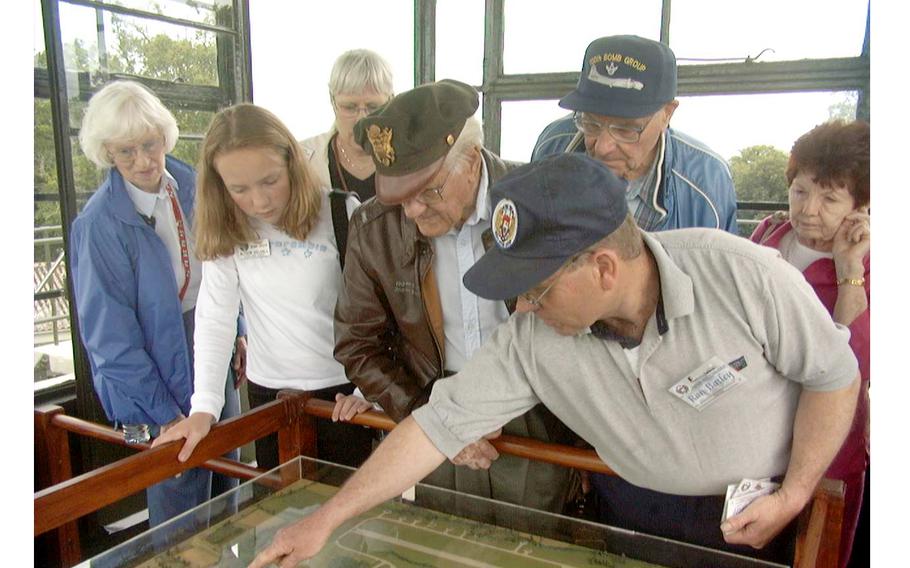
Museum curator Ron Batley, right, explains a display to visitors. Standing next to him in a leather jacket is William “Buzz” Fitzroy, pilot in the 350th Squadron, 100th Bomb Group. On his 35th mission on July 29, 1944, Fitzroy's B-17 was hit by flak and went down. He spent the remainder of the war as a POW in a German prison camp. (Ron Jensen/Stars and Stripes)
This article about WWII veterans from the 100th Bomb Group returning to Thorpe Abbots, England, first appeared in the Stars and Stripes Sunday magazine edition, Aug. 4, 2002. It is republished unedited in its original form. The Apple TV+ miniseries “Masters of the Air,” about the 100th Bomb Group and based on the 2007 book of the same name by Donald L. Miller premiered January 2024.
The field of wheat, spread under a blue sky sprinkled densely with clouds, bobs and weaves in the ever-present English breeze, rippling like a farm pond.
Quiet now, there is little evidence — save for a couple of buildings and some concrete slabs— of the brief period 60 years ago when this patch of earth roared with life. It was a time when flying machines lifted off from this field and flew into combat, returning— some of them, at least —with men thankful to have survived another day.
On a recent weekend, some of those men returned to the wheat field outside Thorpe Abbots, England, about 20 miles south of Norwich and in the middle of nowhere.
The veterans of the 100th Bomb Group looked across the growing crop and with their mind’s eye saw a time when they danced with death, a time when they risked everything. It was a time when they were young.
“Young and stupid,” said William “Buzz” Fitzroy. “You always thought ‘it wasn’t going to be me, it’s going to be someone else.’ That’s the thought you had.”
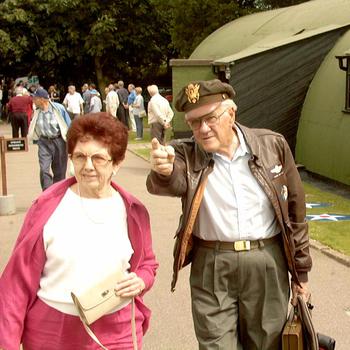
William "Buzz" Fitzroy explains to Lorraine McDaniel the layout of the former airfield at Thorpe Abbots, England. Fitzroy and about 20 other veterans of the 100th Bomb Group visited the site of their old base. (Ron Jensen/Stars and Stripes)
Fitzroy, 82, and living in Clinton, Mississippi, had not been on this piece of ground since July 29, 1944. That day, he left on his 35th mission as pilot of a B-17. All he had to do was return safely and he could turn his back on the war. Thirty-five was the magic number.
“That was my last one,” he said.
It was, too. But not the way he had hoped. His bomber was shot down and he spent the rest of the war in a German prisoner-of-war camp on the Baltic Sea.
Camp life was bearable, but the first few hours of captivity were horrid.
“They beat the hell out of me,” he said. “They shot and hung five of my men.”
His parents were told he was dead and were presented with the Distinguished Flying Cross he was awarded. Several months passed before they heard the unbelievable news of their son’s survival.
Walking up to the site of the old airfield for the first time since that day nearly 60 years ago, Fitzroy was asked how it felt to be back.
He managed only, “It’s …” before emotion prevented any more words from leaving his throat.
Thorpe Abbots was one of scores of airfields built around eastern England from 1942 and on through the war. From the bases, mostly carved from farm fields, the U.S. Army Air Force took the war to the enemy on the European continent.
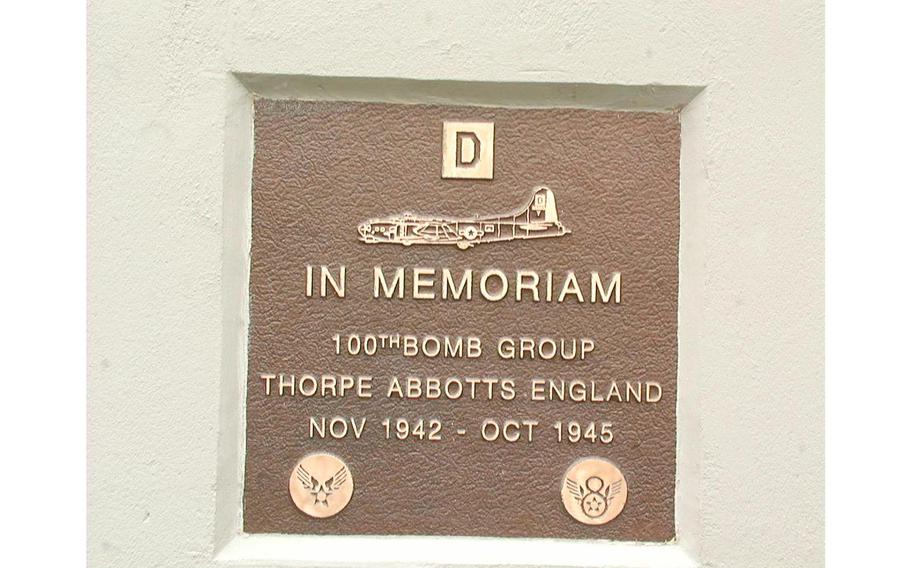
This plaque is attached to the wall of the control tower at the old airfield near Thorpe Abbots, England. Now a wheatfield, the airfield was the wartime home of the 100th Bomb Group. (Ron Jensen)
Most of the bases have disappeared, returned to farmland. At Thorpe Abbots, only a control tower and one building remain from the base, along with some patches of concrete here and there.
But local Englanders, not wanting to see this chapter of the area’s history die, created a museum in the tower and with the help of the 100th Bomb Group Association have created a memorial museum that tells the story of the crews and aircraft of the “Bloody 100th.”
Ron Batley, the museum curator, said the museum has a free 999-year lease from the landowner.
About 20 veterans, most in their 80s, visited the museum in late June. Some had wives and children and grandchildren in tow, some had been there many times before. And some, like Fitzroy, were making their first post-war visit.
“The guys I knew here were the most extraordinary people in the world,” said Alvin Meiklejohn, 79, from Denver, Colo. “It just has a mystical attraction. You can’t believe what went on here— the simply extraordinary things I saw people do.”
The 100th BG flew from Thorpe Abbots from June 1943 until the end of the war in 1945. In those 22 months, the crews flew 306 missions and dropped more than 19,000 tons of bombs.
The gunners were credited with downing 261 enemy aircraft. Additionally, 1,010 were “probably” destroyed and 139 “possibly” destroyed.
On the negative side, 177 aircraft from the 100th were reported missing in action. About 800 crewmen lost their lives.
On the day of the return visit, there was much reminiscing and storytelling.
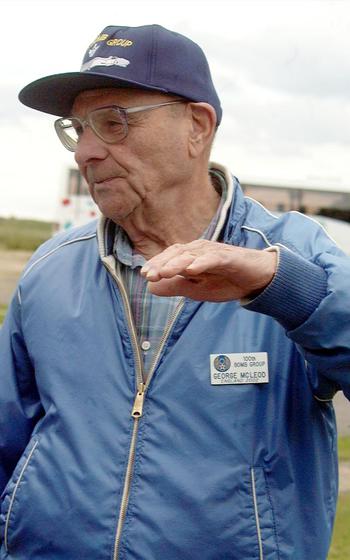
George McLeod's hand serves as a B-17 while he explains an episode during World War II. McLeod and several other veterans of the 100th Bomb Group visited their old airfield at Thorpe Abbots, England, June 22, 2002. (Ron Jensen/Stars and Stripes)
“It was an important part of my life,” said George McLeod, 81, of Anacortes, Wash. “I was one of the lucky ones. I survived.”
He almost didn’t.
On one mission over Germany, his Flying Fortress took three simultaneous flak hits just after releasing its bombs. One of them wounded McLeod, the pilot, and knocked him unconscious, causing him to fall into the controls.
The co-pilot, putting the aircraft into a diving turn as was standard after releasing the bombs, had to hold his commander off the controls and fly the airplane at the same time.
“He’s flying with his right hand and holding me off the stick with his left,” McLeod said. “My co-pilot saved my life.”
There were many close calls.
Glenn Rake, 79, from Sparks, Nev., remembered flying back to Thorpe Abbots in a B-17 with two engines shot out, a flat left tire, a flat tail tire and 234 holes in the aircraft.
“And not a single man wounded. Not one of my men scratched,” he said, still a bit amazed at the luck.
Not everyone was so lucky. Officers shared quarters, Rake said. The four officers on one crew would share a building with officers from six or seven other crews.
“We came home twice and saw all the beds rolled up except for our four,” he said, an indication that all of the other crews had been shot down that day.
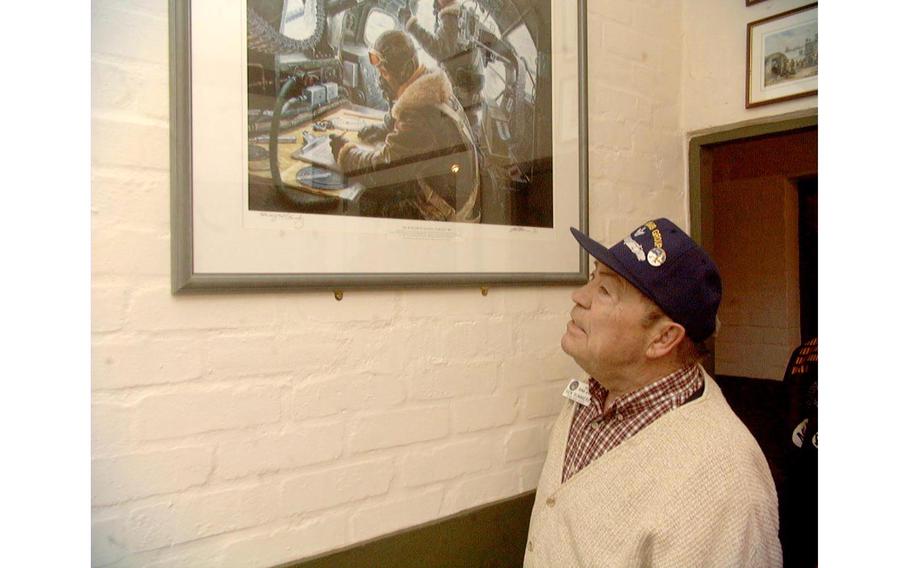
Ken Summers examines a painting hanging in the 100th Bomb Group Memorial Museum at Thorpe Abbots, England, site of the unit's airfield during World War II. Summers was a bombardier in the unit. The museum is in the airfield's old control tower. (Ron Jensen/Stars and Stripes)
Ken Summers, 81, a former bombardier from St. Louis, wondered aloud about the fate of a big tree at the end of the runway.
“Being the bombardier, I was right in the nose,” he said. Every flight, he said, he worried about the pilot smacking that tree, but he pulled up just in time.
Summers didn’t have to worry about the tree after his eighth mission. His plane was shot down over Leipzig, Germany, on Sept. 12, 1944, and he spent the remainder of the war as a POW.
The museum is filled with uniforms, medals, equipment from the B-17s and on and on, the paraphernalia of an air combat unit. It is an impressive display run by volunteers and free to the public.
But the most popular part of the exhibit for the vets was the area that displayed photographs taken by the men of the 100th during their time at Thorpe Abbots and provided to the museum. The vets loved to linger in the photo section, looking for and often finding photos of their particular airplanes.
More than a few photos show the B-17s in less than pristine condition. It was standard to take pictures of an aircraft that had returned to base despite having taken tremendous hits during the mission.
That toughness gave the men great respect for their aircraft. They still insist the B-17 was the best combat aircraft ever to join the U.S. military arsenal.
“They could fly,” Meiklejohn said. “I’ve seen them come back with holes in them big enough you could ride a horse through.”
Fitzroy casually mentioned the time his Fortress was flipped upside down by a burst of flak. The bombs tumbled out of their carriage and tore through the roof of the plane. He turned it back over and flew it home.
The men of the 100th Bomb Group took pains to point out that they do not think they are heroes. Most interviewed volunteered that opinion. They are, they said, simply survivors
They reserve the term “heroes” for the men of the Bloody 100th who never returned.
“I’m here,” said Bob Wolff, 80, from Oxnard, Calif., a pilot who was shot down on his eighth mission. “I’m alive.”
And everyone readily admitted they were scared. Meiklejohn said he and another vet still argue about who was more scared. “He claims he was and I say I was,” Meiklejohn said with a laugh.
But then the retired accountant and lawyer turned serious.
“The funny thing is, while we were scared to death all the time, nobody ever thought of not doing it.”